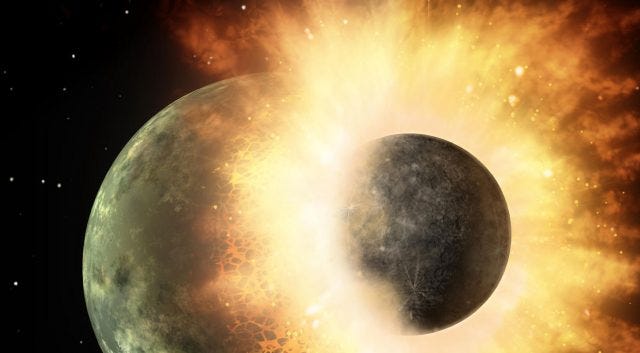New Collision Chain Model Disputes the Great Impact Theory
Written on
Understanding Our Solar System's Origins
The quest to unravel the intricate history of our solar system has captivated brilliant minds for decades. The prevailing theory suggests that while Earth and Venus were clearing their paths, the Moon was created by a colossal impact from a Mars-sized body known as Theia. However, recent findings indicate that this narrative might be too simplistic. In two reports featured in The Planetary Science Journal, a group of researchers has introduced a new "collision chain" model that reexamines the Great Impact hypothesis concerning the formation of our rocky inner planets. This model challenges established beliefs about the formative years of Venus, Earth, and the Moon.
According to Erik Asphaug, the lead researcher, this new perspective suggests that major impacts might not be as straightforward as previously thought. “Our research indicates that many significant impacts, even those deemed 'slow,' often resemble hit-and-run scenarios. For two planets to merge, they typically require a preliminary collision to reduce their speeds,” Asphaug explained. He further posited that understanding events like the Moon's formation as isolated incidents might be misguided, as it likely involved a sequence of two successive collisions.
To illustrate this concept, the authors focus on the relationship between Venus and Earth. Alexandre Emsenhuber, a contributor to one of the papers, elaborated on the idea that the young Earth acted as a kinetic barrier, dampening the momentum of incoming impactors. “We propose that during the formation of the solar system, the early Earth functioned as a protective shield for Venus,” Emsenhuber stated.

The Vanguard Effect Explained
Emsenhuber likens the vanguard effect to a bouncing ball. When a celestial body approaches from the outer solar system, it behaves like a ball bouncing down a staircase, with each bounce representing an impact with another object.
“Throughout its descent, the ball loses energy and will inevitably continue moving downward, never upward,” he noted. “As a result, it can no longer escape the inner solar system. Typically, it only descends toward Venus, and any impactor colliding with Venus will likely remain within the inner solar system, eventually leading to another collision with Venus.”
A second paper released alongside the first employs machine learning to create predictive models based on 3D simulations of significant impacts. The team evaluated their models on both hit-and-run and merging collisions, simulating the formation of terrestrial planets over a span of 100 million years. They further propose and validate their hit-and-run-return model concerning the Moon's formation.
“The conventional model for the Moon necessitates a comparatively slow collision,” Asphaug remarked, “resulting in a Moon primarily composed of the impacting planet rather than the proto-Earth, a significant issue since the Moon's isotopic makeup closely resembles that of Earth.”
In the researchers' revised scenario, a protoplanet similar in size to Mars collides with Earth, mirroring the traditional model. However, instead of the Earth simply absorbing Theia in a single event, the impactor rebounds, creating a chaotic aftermath. It returns after approximately one million years for a subsequent significant impact, this time at a reduced speed — which may hold the key to reconciling existing models with current observations.
“The dual impacts create a far greater mixing effect than a solitary event,” Asphaug explained, “which could clarify the isotopic similarities between Earth and the Moon, as well as how a second, slower merging collision could occur.”
This model may also shed light on the differing chemical compositions of Earth and Venus. As Asphaug noted, impactors that grazed Earth would have been pushed deeper into the Sun’s gravitational pull, meaning that “Earth primarily accumulated its materials from direct hits or slower collisions, while more oblique, higher-velocity impacts would preferentially contribute to Venus.”
One might expect Earth to be more composed of material from the outer solar system due to its proximity. However, with Earth playing a protective role, it is more plausible that Venus acquired greater outer solar system material.
Now Read:
- The Remnants of Theia May Still Exist Deep Inside the Earth
- The Formation of the Moon May Have Stretched the Earth Into a Potato
- NASA Study: Moon Is Made of Material From Earth, Not Theia
This video discusses the implications of the new collision chain model and its challenges to the existing Great Impact Theory.
This video explores a new supercomputer simulation that reveals insights into the Moon's origin and its connection to early Earth.